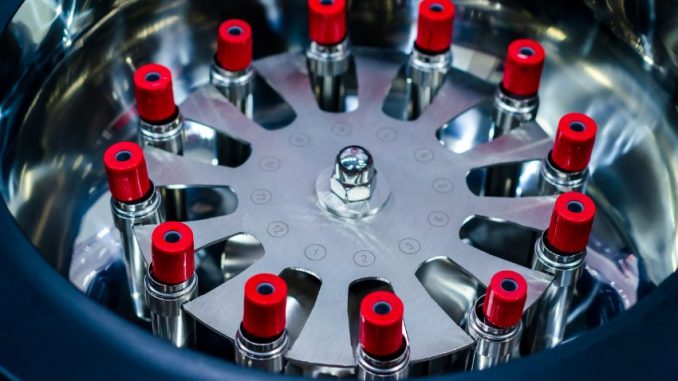
Introduction
Centrifugation is one of the standard technologies in the food and biochemical engineering industry for separating particulates from fluids. Some classic examples include the separation of fruit material from its juice, the recovery of cell debris from a fermentation broth and the recovery of precipitates from a reaction medium. It is one of the classic techniques in downstream processing.
The technology relies on centrifugal force to separate materials of differing densities. This centrifugal force is created by extremely rapid spinning of material in a centrifuge rotor. The denser the material the more likely it will move away from the axis of centrifugation.
The centrifugal force is found according to the equation:
F=mω2 r
Where F= intensity of the centrifugal force, m= effective mass of the sedimenting particle, ω= angular velocity of rotation which is squared in this equation and r= distance of the migrating particles from the central axis of rotation.
It is much more common to quote the centrifugal force F in terms of the Earth’s gravitational force, g. Very often you can see the performance of a centrifuge quoted as RCF which is the relative centrifugal force or g force.
RCF = (1.119 x 10-5 (rpm)2 (r)
Compared to filtration, it is much faster. At the industrial level it is the only technology suited for the separation of two immiscible liquids and a solid phase in a continuous system. It is also better than membrane technology for separating coagulated suspensions, flocculated materials, hazes and filamentous materials.
Types Of Centrifuge
Centrifuges can be operated in batch or continuous mode. The retained material which is often called the cake is washed in water or a solvent to remove impurities. To improve centrifugation, material can be gravity settled or filtered beforehand. Cell aggregates and flocs are often generated by adding coagulants including acids and bases, or salts. Polyelectrolytes and salts such as calcium chloride, ferric chloride etc. are added as part of flocculation technology.
(1) Tubular Bowl Centrifuge
The most common types are the tubular bowl centrifuge or tubular centrifuge. It is ideal for recovery of microbial cells, animal and plant cells from their fermentation media without causing too extensive damage to the integrity of the cells.
It is often employed for the separation of two distinct immiscible phases such as:-
- solids versus liquids
- heavy liquids versus light liquids
- heavy liquids, light liquids and solids
Extremely useful for solid-liquid separations but it is an ideal system for separating two liquid phases as well as long as there is a relative difference in their densities. In this case the two liquid phases are called the light-liquid phase and the heavy-liquid phase.
A good example is the recovery of fruit juice such as strawberry juice from crushed strawberry fruit. Another classic example in food processing is the separation of milk into skimmed milk and cream.
A typical centrifuge is made up of a tall and narrow bowl between 10 an 15 cm in diameter. It is usually rotated within a chamber at speeds up to 15,000 rpm. Feed enters through a nozzle at the bottom of the tubular bowl which is rotating at very high speed. The heavier liquid or particles are thrown out from the centre whilst the lighter liquid remains at the centre of the bowl. These two phases will move up the bowl. The two phases are separated using an adjustable ring where they are discharged from the device.
Such centrifuges cannot handle very heavy loads if they are up to 10% solids content or containing particles between 0.1 and 200 microns in size. It will not work with three phase systems either.
(2) Disc Bowl or Disc Stack Centrifuge
A widely developed and implemented process for separating cellular material. It is commonly employed in recovering microbial cell debris and protein precipitates.
An example of this type of centrifuge in the spinning cone which is used to separate flavour components.
(3) Perforate Bowl Basket Centrifuge
A centrifuge used for the removal of liquids from sludges, for separating oil from water, for removing pomace from juice before fermentation, recovery of adsorbents used in chromatography and solid-phase extractions. Small-scale versions are available as kitchen equipment. The Acme Supreme Juicerator-6001 is ideal for dejuicing fruit and vegetables.
(4) Zonal Ultracentrifuge
A technology relying on extremely high g values. It has been successfully employed in recovering cell debris from supernatants of an almost similar density. Very fine precipitates such as flocs and those of proteins are often collected. One of the key parts of the processing purifying enzymes such as RNA polymerase from cell debris.
Gradient centrifugation is used to separate bands of DNA using a cesium chloride or a sucrose gradient. During centrifugation, DNA and protein molecules in a suspension are forced to their furthest point from their centre of rotation. The gradient is based on density and the separating molecules eventually stop at a point in the gradient where it is equal to their own density.
Issues With Centrifugation
Any centrifuge will suffer vibrations during start-up and shut-down (Regel et al., 2001). Amplified vibration is common during these phases. It is a good idea to monitor the centrifuge’s vibration level during operation. There is always wear and tear during operation.
Sudden vibrations occur when parts break because missing mass produces an immediate imbalance in the spindle.
A vibrational engineer should identify specific issues associated with operation and assess performance.
In some cases during shut-down the centrifugal force is no longer present because bowl rotation starts to slow down. If the sludge is not compact enough it can dislodge from the bowl at the top and fall due to gravity. Any transfer leads to a temporary imbalance and then excessive vibration occurs. Vibration can also be transmitted from the external environment to the centrifuge.
References
Regel, L.L., Wilcox, W.R., Derebail, R., Skudarnov, P.V. (2001). Vibration During Centrifugation. In: Regel, L.L., Wilcox, W.R. (eds) Processing by Centrifugation. Springer, Boston, MA. (Article)

Leave a Reply